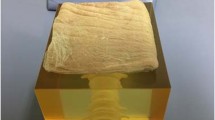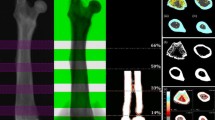Abstract
Objectives
We estimated the in vivo reproducibility of trabecular bone score (TBS) from dual-energy X-ray absorptiometry (DXA) using different imaging modes to be compared to that of bone mineral density (BMD).
Methods
We enrolled 30 patients for each imaging mode: fast-array, array, high definition. Each patient underwent two DXA examinations with in-between repositioning. BMD and TBS were obtained according to the International Society for Clinical Densitometry guidelines. The coefficient of variation (CoV) was calculated as the ratio between root mean square standard deviation and mean, percent least significant change (LSC) as 2.77 × CoV, reproducibility as the complement to 100 % LSC.
Results
Fast-array imaging mode resulted in 0.8 % CoV and 2.1 % LSC for BMD, 1.9 % and 5.3 % for TBS, respectively; array imaging mode resulted in 0.7 % and 2.0 % for BMD, 1.9 % and 5.2 %, for TBS; high-definition imaging mode resulted in 0.7 % and 2.0 %, for BMD; 2.0 % and 5.4 % for TBS, respectively. Reproducibility of TBS (95 %) was significantly lower than that of BMD (98 %) (p < 0.012). Difference in reproducibility among the imaging modes was not significant for either BMD or TBS (p = 0.942).
Conclusion
While TBS reproducibility was significantly lower than that of BMD, differences among imaging modes were not significant for both TBS and BMD.
Key Points
• TBS is an emerging tool for assessing BMD.
• TBS reproducibility is lower than that of BMD.
• Differences between imaging modes are not significant for either TBS or BMD.

Similar content being viewed by others
References
(2001) NIH Consensus Development Panel on osteoporosis prevention, diagnosis and therapy. JAMA 285:785–795
Bouxsein ML, Seeman E (2009) Quantifying the material and structural determinants of bone strength. Best Pract Res Clin Rheumatol 23:741–753
Kanis JA, Borgstrom F, De Laet C et al (2005) Assessment of fracture risk. Osteoporos Int 16:581–589
Brandi ML (2009) Microarchitecture, the key to bone quality. Rheumatology 48:iv3–iv8
Wainwright SA, Marshall LM, Ensrud KE et al (2005) Hip fracture in women without osteoporosis. J Clin Endocrinol Metab 90:2787e2793
Pothuaud L, Carceller P, Hans D (2008) Correlations between grey-level variations in 2D projection images (TBS) and 3D microarchitecture: applications in the study of human trabecular bone microarchitecture. Bone 42:775–787
Bousson V, Bergot C, Sutter B et al (2012) Trabecular bone score (TBS): available knowledge, clinical relevance, and future prospects. Osteoporos Int 23:1489–1501
Schousboe JT, Shepherd JA, Bilezikian JP et al (2013) Executive summary of the 2013 International Society for Clinical Densitometry Position Development Conference on bone densitometry. J Clin Densitom 16:455–466
Hans D, Goertzen AL, Krieg MA et al (2011) Bone microarchitecture assessed by TBS predicts osteoporotic fractures independent of bone density: the Manitoba study. J Bone Miner Res 26:2762–2769
Dufour R, Winzenrieth R, Heraud A (2013) Generation and validation of a normative, age-specific reference curve for lumbar spine trabecular bone score (TBS) in French women. Osteoporos Int 24:2837–2846
Briot K, Paternotte S, Kolta S et al (2013) Added value of trabecular bone score to bone mineral density for prediction of osteoporotic fractures in postmenopausal women: the OPUS study. Bone 57:232–236
Popp AW, Guler S, Lamy O et al (2013) Effects of zoledronate versus placebo on spine bone mineral density and microarchitecture assessed by the trabecular bone score in postmenopausal women with osteoporosis: a three-year study. J Bone Miner Res 28:449–454
Hopkins SJ, Welsman JR, Knapp KM (2014) Short-term precision error in dual energy x-ray absorptiometry, bone mineral density and trabecular bone score measurements; and effects of obesity on precision error. J Biomed Graph Comput 4:8–14
Nielson CM, Srikanth P, Orwoll ES (2012) Obesity and fracture in men and women: an epidemiologic perspective. J Bone Miner Res 27:1–10
Bandirali M, Sconfienza LM, Aliprandi A et al (2014) In vivo differences among scan modes in bone mineral density measurement at dual-energy X-ray absorptiometry. Radiol Med 119:257–260
Link TM (2012) Osteoporosis imaging: state of the art and advanced imaging. Radiology 263:3–17
Bolotin HH (2007) DXA in vivo BMD methodology: an erroneous and misleading research and clinical gauge of bone mineral status, bone fragility, and bone remodelling. Bone 41:138–154
Kanis JA (2002) Diagnosis of osteoporosis and assessment of fracture risk. Lancet 359:1929–1936
Kanis JA, Hans D, Cooper C et al (2011) Task force of the FRAX initiative. Interpretation and use of FRAX in clinical practice. Osteoporos Int 22:2395–2411
Silva BC, Leslie WD, Resch H et al (2014) Trabecular bone score: a noninvasive analytical method based upon the DXA image. J Bone Miner Res 29:518–530
Bandirali M, Lanza E, Messina C et al (2013) Dose absorption in lumbar and femoral dual energy X-ray absorptiometry examinations using three different scan modalities: an anthropomorphic phantom study. J Clin Densitom 16:279–282
Acknowledgments
The scientific guarantor of this publication is Prof. Francesco Sardanelli. The authors of this manuscript declare no relationships with any companies, whose products or services may be related to the subject matter of the article. The authors state that this work has not received any funding. One of the authors has significant statistical expertise. Institutional review board approval was obtained. Written informed consent was obtained from all subjects (patients) in this study. Methodology: prospective, experimental, performed at one institution.
Author information
Authors and Affiliations
Corresponding author
Rights and permissions
About this article
Cite this article
Bandirali, M., Poloni, A., Sconfienza, L.M. et al. Short-term precision assessment of trabecular bone score and bone mineral density using dual-energy X-ray absorptiometry with different scan modes: an in vivo study. Eur Radiol 25, 2194–2198 (2015). https://doi.org/10.1007/s00330-015-3606-6
Received:
Revised:
Accepted:
Published:
Issue Date:
DOI: https://doi.org/10.1007/s00330-015-3606-6




